If you’ve walked around downtown Austin, something you’ve probably noticed is that a lot of buildings built recently and a lot of buildings under construction have cut corners. No, I don’t mean they’ve used shoddy construction. I mean that, literally, they’re shaped as a rectangle with a corner cut off. Sometimes there’s just no building there; sometimes there’s a much shorter part of the building with just the tower component missing. It’s so common that it’s almost becoming Austin’s signature building style. How come?
Development
How the Convention Center Expansion Proposal Has Improved and What’s Still Needed
Last November, I was appointed as a member of the Visitor Impact Task Force created by the City Council to look into the positive and negative impacts of tourism in Austin, as well as put together recommendations regarding the potential expansion of the Convention Center. I came in an expansion skeptic but I voted for expansion. Y’all deserve an explanation. So here are four ways the Task Force’s recommendations for the convention center expansion improved on the proposal we had coming in, followed by some thoughts on what’s needed from here.
1 Keeping the Street Grid In Place
Street connections are vital for making great places. For people driving cars, they mitigate traffic by providing alternative routes. For people walking, they increase the storefront-to-walking-distance ratio, making more destinations like restaurants and bars in walking distance. Not all uses are compatible with street connections — in downtown Austin, many potential street connections near government buildings are blocked off for security reasons. Some alleys (small streets in a sense) have been removed because they’re incompatible with the uses of the building.
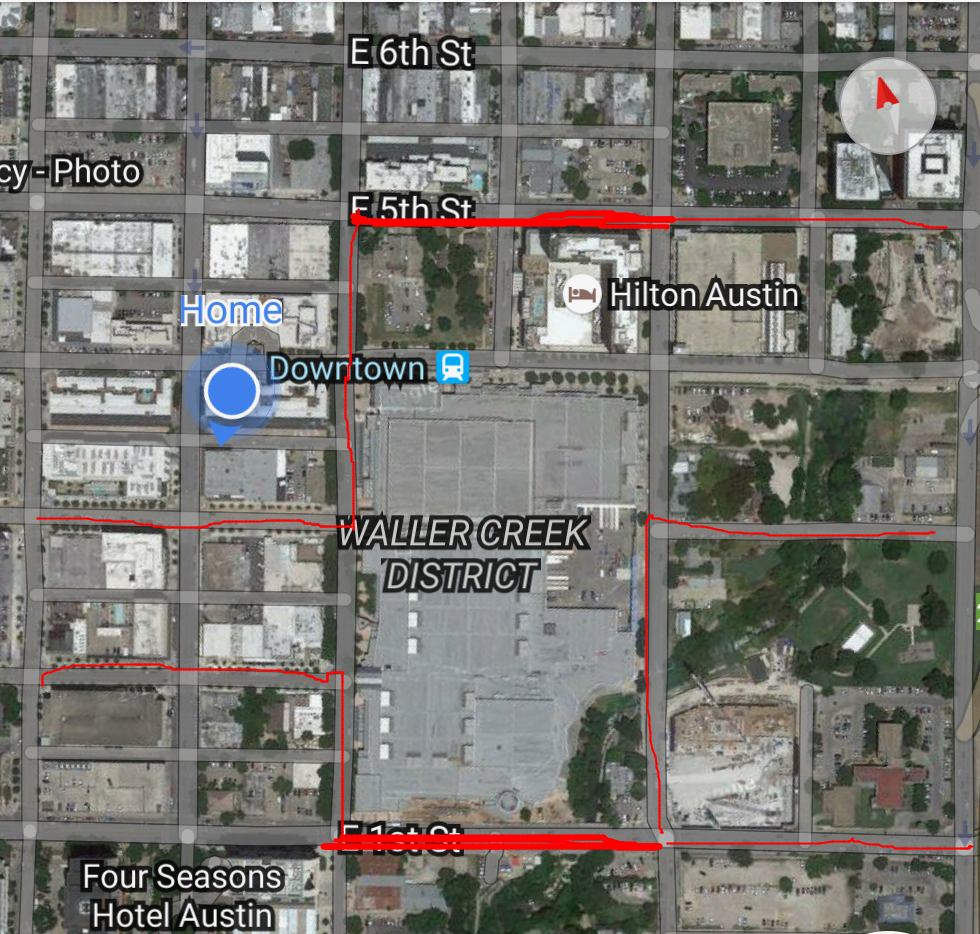
One of the worst areas for street connectivity downtown is the existing Convention Center. I lived next to it for years, walking everywhere and in every direction on my own two feet before I discovered on a map that there was a city park blocks from me on the other side of the Convention Center. The lack of streets in the area made it harder to discover destinations even when they were there. The original plan for the expansion doubled down on this unwalkable dead area by closing off two more city blocks (2nd and 3rd St from Trinity to San Jacinto). Following the recommendations of the Design Commission and many architecturally-oriented citizens, the Task Force specifically called out maintaining the street grid as one of our design recommendations.
2 Bringing More Uses to the Southeast Quadrant
The Convention Center is a rare nine-city-block square downtown with a single use. The convention center’s maximum practical capacity is about 65% of the days of year, due to days like Christmas when nobody wants to hold a conference and the setup/teardown time for flipping conference space. Even when conferences are in town, conferences themselves are not typically all-day affairs, so there are still significant dead times. As a result, while the convention center area can feel very crowded at specific times when conferences are letting out, a lot of the time it feels empty. As many locals told me, “I have no reason to go there.” Right in the middle of downtown, it’s home to many storefronts that don’t even bother opening except for special events.
The original Convention Center plan recognized this and recommended integrating retail and restaurants into the expansion, but this really didn’t go far enough. Locals without a reason for being in the area rarely go out of their way to get there. At the suggestion of the Design Commission, the Task Force recommended that any Convention Center design be integrated not only with ground floor retail but also with other uses such as office or residential. This should both help locals (both residential and office space are at a premium downtown right now) and visitors, by giving visitors a chance to explore the same Austin as locals. In this way, you could conceive of the project as a convention center expansion with a residential component, or merely another residential tower, but with room for the convention center in it.
3 Potentially Saving Money by Integrating with Other Uses
Estimates for the Convention Center’s plans for redevelopment came it at an eye-popping $559m before land acquisition costs, estimated at about $100m or more. The cost estimates were done without a detailed design document, so they could be significantly off. The Task Force’s recommendation described above (housing expansion within a larger private sector development) has the potential to cut down on these costs by sharing development costs across many uses. Without detailed design estimates, we can’t know whether this will pay off, but there’s reason to believe it could!
4 The Convention Center Expansion will be integrated with other efforts
The convention center’s original expansion plan recognized the need for any new building to not be an island unto itself but integrated into its surroundings. Toward that end, it spoke of not just a convention center expansion, but an entire Convention Center District.
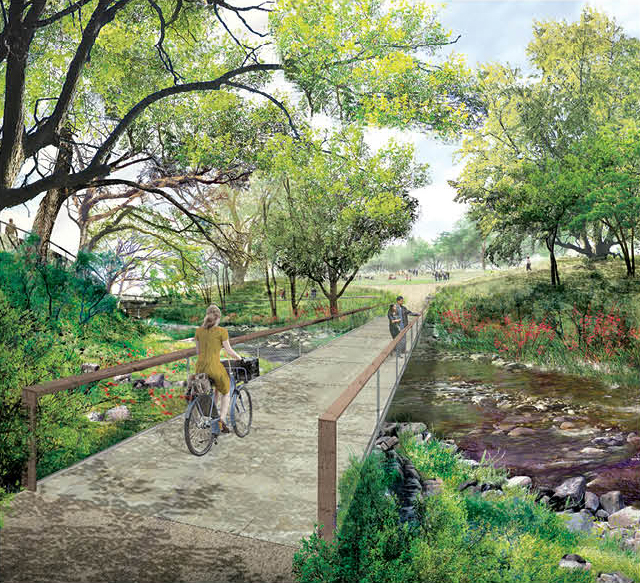
Disappointingly, the plans as written did a very poor job of imagining not just how the outside world could be reshaped to benefit the convention center, but how the convention center could be reshaped to take its place in the city. Downtown belongs to no one industry, group, or activity. Our zoning, unlike most other areas in the city, allows a vast array of uses, from hotels to apartments, offices to bars, parks to shelters, all next to one another. Within blocks of the Convention Center, there are already many different planning efforts underway. The Waller Creek Conservancy is leading the development of a grand new linear park along Waller Creek. (The creek itself is adjacent to the Convention Center.) A transportation planning study for the Rainey St area (a difficult pedestrian crossing across Cesar Chavez from the convention center) was recently completed.
In the vision that the Task Force put forward, we recognized this and took a few steps: 1) we recommended that City Council put out a Request For Information (which would typically lead to a Request for Proposal) on designs for this area; 2) we recommended that improvements to the immediate vicinity of the Convention Center area (a category of expenditure allowed when improving a Convention Center) be coordinated with other planning efforts in the area, such as the Waller Creek Conservancy. 3) We recommended examining the possibility of extending the Waller Creek TIF to use tax revenues from new development toward urgent social priorities downtown.
What still needs to be done
Given the big changes coming out of the Task Force and the fluid nature of the project, now is the perfect time for people to be thinking big. What could be done in this corner of downtown to make this place the best it can be for tourists and Austinites alike? We are too early for public input on the question: the Task Force has agreed to but not yet released its report; the City Council has not yet heard it, let alone taken action on it. But we’re never too early for a good brainstorm.
Announcing the new #atxrising contest
There’s an Austin, and Austin on Your Feet, tradition to use the hashtag #atxrising to post pictures of new construction in Austin. This could be anything from parks to single-family homes to downtown high-rises.
For the first time ever, Austin on Your Feet will host a contest!
The first windows were installed at the Independent! #ATXrising #IndATX58 pic.twitter.com/qsIkoNznq1
— Justin Baudoin (@justinbaudoin) May 7, 2017
5th/Brushy office project (iirc) achieving hole in ground status. Fairmont in background left. #atxrising pic.twitter.com/CnGVLUCIOq
— Dan Keshet (@DanKeshet) March 23, 2017
All you have to do to enter is tweet a picture of construction in Austin with the hashtags #atxrising and #atxonyourfeet sometime in the next week to win! It can be a picture you’ve posted previously. If you want to nominate somebody else’s picture, that works too, but the prize will go to the photographer! The top three pictures will win a fabulous urbanist book: Tactical Urbanism by Mike Lydon, The High Cost of Free Parking by Donald Shoup, or The Death and Life of Great American Cities by Jane Jacobs.
good morning Austin. ☕ #ATXrising pic.twitter.com/utd8DHqE4c
— ely with machine (@mwhitney_atx) February 25, 2017
So get snapping and get tweeting!
https://twitter.com/ewaltersTX/status/824444047985147905
6 reasons to be skeptical of pouring more money into the convention center
The Austin Convention Center is considering expanding to another 3 blocks downtown. Here’s 6 reasons to be skeptical:
1. The Convention Center Loses An amazing Amount of Money
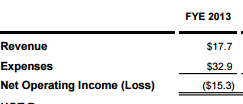 Even though the convention center doesn’t pay rent like a normal business, it loses stacks and stacks of money: $15.3m in 2013. It takes skills to run a business well enough to pay downtown rents. It takes special skills to run a rent-free business downtown and lose twice as much money as you make!
Even though the convention center doesn’t pay rent like a normal business, it loses stacks and stacks of money: $15.3m in 2013. It takes skills to run a business well enough to pay downtown rents. It takes special skills to run a rent-free business downtown and lose twice as much money as you make!
2. The Convention Center Taxes Every Visitor to Austin To Subsidize Their Customers
The only way the Convention Center can balance its budget is to take the lion’s share of the city’s $9 tax on every $100 that every single tourist spends on hotels in Austin–whether they’re in the very small minority here for a convention or the vast majority here to listen to music, visit family, do business, go to Lake Austin, watch a UT game, or any other reason! A case can certainly be made that we should tax visitors to pay for things many visitors want but don’t make much money–parks, music, arts, museums. But we spend the vast majority of our tourist taxes on just one thing–the convention center.
3. The Convention Center Is a Giant Tax Dodge
Unlike the Convention Center, most downtown buildings pay huge sums on property taxes: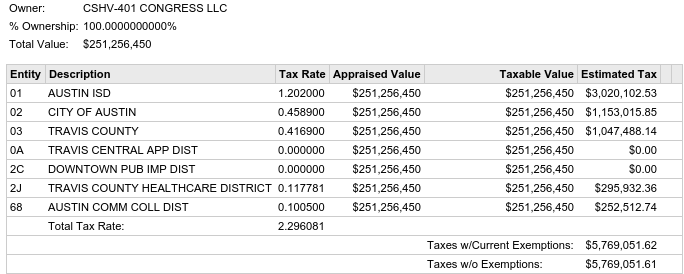
- 100 Congress: $3.69m
- JW Marriott convention facilities/hotel: $5.24m
- Frost Tower: $5.77m
- Austonian: A lot! But harder to calculate.
- 6-block convention center: $0.
 If the Convention Center takes even more blocks off of the tax rolls, that could pull millions more dollars in potential taxes away from the city, the county, and Austin schools. That’s a property tax break EVERY SINGLE YEAR that we will be using to subsidize the convention industry.
If the Convention Center takes even more blocks off of the tax rolls, that could pull millions more dollars in potential taxes away from the city, the county, and Austin schools. That’s a property tax break EVERY SINGLE YEAR that we will be using to subsidize the convention industry.
4. The Convention Center Economic Analysis is Really weak
When people come to conventions, they spend money at hotels, bars, and restaurants. That’s good–it puts people to work and generates tax dollars. But downtown condo dwellers and office workers not only spend money on lunch and cocktails, they also spend money on legal services and dentists and furniture and everything else, not to mention taxes that pay for schools and streets and parks. Is the economic activity generated by conventions more than that generated by other uses? Enough more to justify giving tax incentives? Do we lose any non-convention tourism business because of the costs of our hotel taxes? Are there better uses for our tourist taxes than more convention center? The analysis doesn’t even ask these questions, let alone try to answer them. C’mon guys! You’re asking City Council and taxpayers to invest $400m in a money-losing business and your business case doesn’t answer the most basic questions.
5. The Convention Center Screws up traffic

Most buildings downtown are pretty small and reserve their disruptive traffic (trash collection, loading/unloading) for alleys. Some buildings, like the W or the JW Marriott, take up a full city block, which forces disruptive traffic into the street itself. The Convention Center one-ups even these buildings by shutting down 7 combined blocks of 2nd St, 3rd St, and Neches, forcing all nearby traffic onto crowded streets like Cesar Chavez, 4th, 5th, Trinity, and Red River. Like channelized water with nowhere else to go, traffic on Cesar Chavez regularly floods. The new plan mostly envisions keeping Trinity open; it needs to go much further to keep all existing streets open.
6. The Convention Center is a bad neighbor
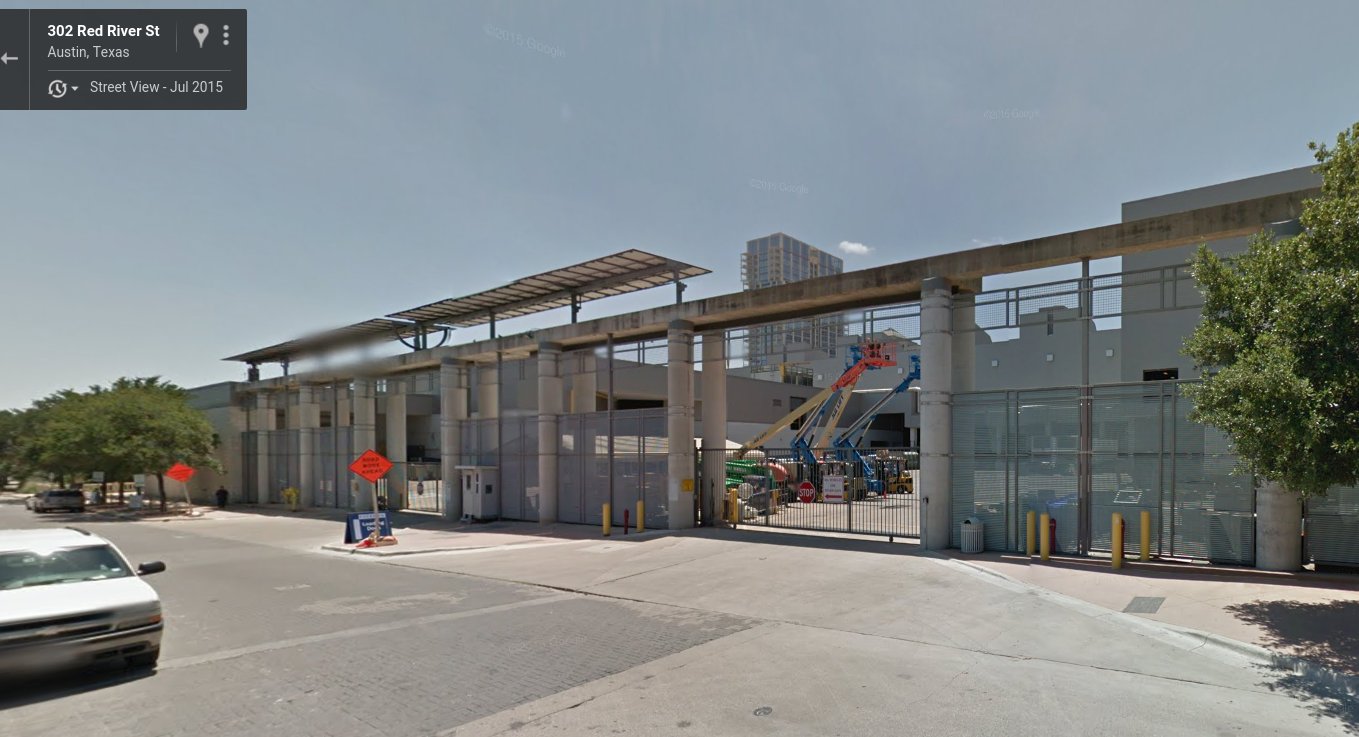
Most developers downtown don’t just make a nice new building, they spruce up the area around them a bit too. The Independent condo tower is extending out the Shoal Creek Trail and building a pedestrian bridge. The 70 Rainey apartments are fixing up a park on the lot next door to them and building a wall covered in plants so neighbors have something pleasant to look at. The Convention Center has built one of the ugliest walls in all of downtown, helping to make Palm Park one of the most unloved and forgotten parks in the city. They say they’ve learned their lesson and they want to make the expanded section better. It would be a lot easier to believe them if they cleaned up their act first and put some real money toward fixing up Waller Creek and Palm Park and maybe trying to figure out some way to undo the ugliness of their current building. (Full disclosure: I’m affiliated with the awesome Generation Waller, but I’m speaking for myself.)
So, basically, you hate this expansion plan?

Really, not as much as this article makes it seem. But if the convention center authority wants us to believe their goal is improving the city, not securing their budget, they need to seriously step it up:
- ACVB says demand for conventions is so high, they’re turning conventions away. If so, they should be able to raise prices and stop bleeding so much money. If they can’t even raise prices on a money-losing enterprise, we should really question the whole idea of expansion.
- ACVB says they’ve learned design lessons from the terrible mauseoleum approach to building a dead building and destroying downtown street life. Prove it! Put real design sense and money into fixing the existing building first to show you now know what you’re doing. Improvements on the south side are a great start; now address the gaping holes on the east side.
- ACVB should be a good neighbor! Put more money into fixing up Waller Creek and Palm Park, following the Waller Creek Conservancy vision. Put more money back into the music community, one of the major selling points of Austin as a tourism and convention destination. Promoting Austin as a city should be about more than exhibit spaces and hotel room counts. It should be about keeping Austin a place that people want to be!
When the convention center was expanded in 2002, the world was a very different place. Downtown was filled with many low-value, low-intensity uses like surface parking lots and auto lots. One more low-slung ugly building fit in just fine. But now, the city is not approaching the convention center hat in hand desperately looking for jobs and downtown activity. The alternative to a convention center expansion isn’t a dead downtown; it’s a downtown Austin that continues to be one of the most prosperous, livable, desirable places to be in the entire state of Texas, radiating tax dollars out to fund the city. The Convention Center needs to understand this and improve their offer.
In addition, the days when the public was happy to give tax incentives to big businesses to get new jobs are over. Unemployment is scraping bottom in the city of Austin and City Council is rejecting hotel jobs (like the East Cesar Chavez hotel) even when they aren’t subsidized. Multiple bonds for 9-figure public projects like this one have been rejected by the public, for better or worse. An expansion plan that looks like a solid business plan for a money-making business will look an awful lot better to the incentives-wary Council members and public than red ink forever on an ever-growing budget.
8 ways the Texas Capitol is going to radically change…for the better!
The Texas Facilities Commission has produced a radical new document [warning: HUGE], outlining the ways they want to completely overhaul our state capitol. Check out some of their new ideas:
3 types of affordable housing in Burnet / Rockwood debate
I’ve previously discussed the difference between two kinds of affordable housing: the mandatory kind (means-tested, reduced rent programs) and the market kind (housing that is inexpensive on the open market). In the Burnet / Rockwood case (history: 1, 2), however, there were really three concepts of affordable housing under discussion: lowering market rents, providing selective rent reductions, and providing deeply affordable housing for the very poor.
Councilmembers’ approach to zoning, in their own words, part 2
Last month, City Council took up one of their first large zoning cases, a proposed apartment complex near Burnet Road. Many of them used the opportunity to expound not only on the case in question, but some of the principles behind their decision, and I duly blogged those takes. Zoning changes require 3 “readings” (i.e. 3 different votes). If there’s no disagreement, all 3 readings can happen on the same night. But in this case, there was disagreement, so they only passed the vote “on first reading,” and this last Thursday, revisited it. If you’re interested in the background and outcome of the decision, check out Liz Pagano’s take in the Austin Monitor. Me, though? I’m interested in hearing what the Council Members had to say about their approach to zoning.
District 10 Council Member Sheri Gallo
Gallo here notes that the majority of Austin rents, neighborhood associations don’t always do a good job representing them, and it’s the responsibility of City Council to look out for all residents, not just the organized ones. Readers of this blog will be familiar with both the renting and neighborhood association ideas.
Here, Gallo gives her opinion that the reason why rents have risen in Austin is an imbalance of supply and demand, and suggests more housing supply is needed to stop price increases. This, again, is familiar territory on this blog.
District 3 Council Member Pio Rentería
CM Rentería, similar to CM Gallo, believes that raising supply will stabilize prices.
District 4 Council Member Greg Casar
Casar offers a number of ideas here. First, he discusses a “filtering up” mechanism, where, if new housing doesn’t get built, old (or “vintage”) housing can become more expensive, giving as an example housing his brother lives in in Los Angeles.
Another two ideas that Casar argues for are that: 1) building housing is in and of itself, a “community benefit.” 2) There is an additional “economic integration” community benefit to having some portion of that housing be mandated Affordable Housing. Neither of these ideas are new to council. Nevertheless, it’s interesting to hear both of them in the same speech. Frequently, the “economic integration” argument appears on the side of somebody arguing against denser zoning. In this case, though, Casar appeared to be arguing for greater density as a mechanism for making more Affordable Housing economically viable for the developer.
Mayor Steve Adler
I publish this not because Adler offered much background on his approach to zoning here, but because of the previous rarity of seeing a Council Member ask a developer to consider greater density on a site. (Sorry, I accidentally cut the video short; the developer said yes, he would consider it.)
District 2 Council Member Delia Garza
Garza offers two items of note: 1) delays in the development process add to the costs of housing, and 2) Austin is a high-demand city, and when there isn’t enough housing supply in richer areas, this adds to gentrification pressures in poorer areas.
District 8 Council Member Ellen Troxclair
Troxclair offers a bit of a procedural take, arguing that Council’s way of using zoning as a negotiation tool encourages parties to take extremist positions. She appears to have misspoke when she said she couldn’t support MF6; she voted, as she did in the previous reading, for the higher-density MF6 and against the lower-density zoning.
The Developer
Finally, we hear from the applicant, C.J. Sackman, the developer of the project. I’m including this testimony not because his views will have lasting impact on the Council the way that Council Members’ do, but because they’re broadly representative of developers’ views.
The Rest
CM Pool (District 7), CM Kitchen (District 5), and CM Houston (District 1) emphasized that, because there was disagreement between a neighborhood association objecting to the project and the developer and because the two hadn’t fully negotiated, they wanted to pass a lower zoning category on 2nd reading only, to pressure the two sides to negotiate. CM Zimmerman (District 6) thought there had been enough testimony, and moved for the decision to be made for the higher zoning category on 3rd reading. Mayor Pro Tem Tovo (District 9) voted with Pool, Kitchen, and Houston. In her testimony, Tovo focused on whether the developer could have provided steeper discounts on the Affordable Housing apartments, to target a poorer population.
2014 in Downtown, in Words and Pictures
2014 was a big year for downtown Austin. Major themes as I see them:
